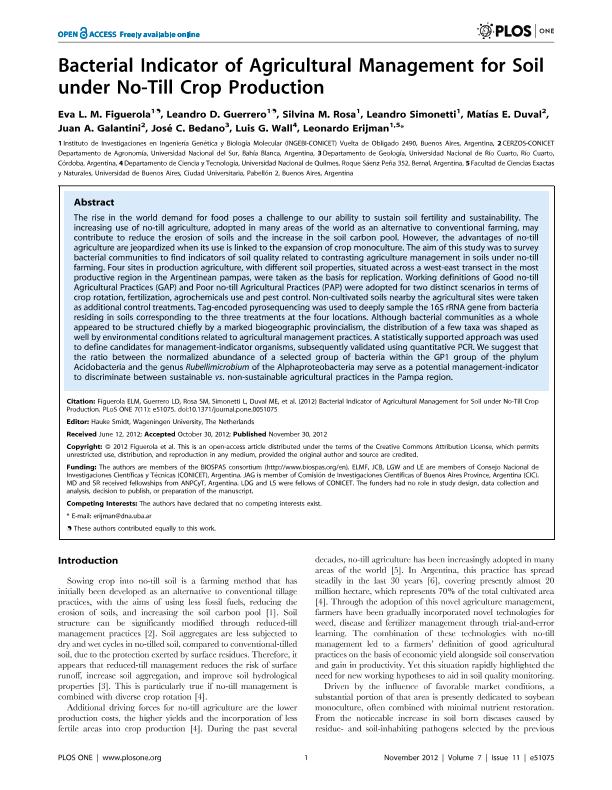Artículo
Bacterial Indicator of Agricultural Management for Soil under No-Till Crop Production
Figuerola, Eva Lucia Margarita ; Guerrero, Leandro Demián
; Guerrero, Leandro Demián ; Rosa, Silvina Mariana
; Rosa, Silvina Mariana ; Simonetti, Leandro
; Simonetti, Leandro ; Duval, Matias Ezequiel
; Duval, Matias Ezequiel ; Galantini, Juan Alberto; Bedano, José Camilo
; Galantini, Juan Alberto; Bedano, José Camilo ; Wall, Luis Gabriel
; Wall, Luis Gabriel ; Erijman, Leonardo
; Erijman, Leonardo
 ; Guerrero, Leandro Demián
; Guerrero, Leandro Demián ; Rosa, Silvina Mariana
; Rosa, Silvina Mariana ; Simonetti, Leandro
; Simonetti, Leandro ; Duval, Matias Ezequiel
; Duval, Matias Ezequiel ; Galantini, Juan Alberto; Bedano, José Camilo
; Galantini, Juan Alberto; Bedano, José Camilo ; Wall, Luis Gabriel
; Wall, Luis Gabriel ; Erijman, Leonardo
; Erijman, Leonardo
Fecha de publicación:
11/2012
Editorial:
Public Library of Science
Revista:
Plos One
ISSN:
1932-6203
Idioma:
Inglés
Tipo de recurso:
Artículo publicado
Clasificación temática:
Resumen
The rise in the world demand for food poses a challenge to our ability to sustain soil fertility and sustainability. The increasing use of no-till agriculture, adopted in many areas of the world as an alternative to conventional farming, may contribute to reduce the erosion of soils and the increase in the soil carbon pool. However, the advantages of no-till agriculture are jeopardized when its use is linked to the expansion of crop monoculture. The aim of this study was to survey bacterial communities to find indicators of soil quality related to contrasting agriculture management in soils under no-till farming. Four sites in production agriculture, with different soil properties, situated across a west-east transect in the most productive region in the Argentinean pampas, were taken as the basis for replication. Working definitions of Good no-till Agricultural Practices (GAP) and Poor no-till Agricultural Practices (PAP) were adopted for two distinct scenarios in terms of crop rotation, fertilization, agrochemicals use and pest control. Non-cultivated soils nearby the agricultural sites were taken as additional control treatments. Tag-encoded pyrosequencing was used to deeply sample the 16S rRNA gene from bacteria residing in soils corresponding to the three treatments at the four locations. Although bacterial communities as a whole appeared to be structured chiefly by a marked biogeographic provincialism, the distribution of a few taxa was shaped as well by environmental conditions related to agricultural management practices. A statistically supported approach was used to define candidates for management-indicator organisms, subsequently validated using quantitative PCR. We suggest that the ratio between the normalized abundance of a selected group of bacteria within the GP1 group of the phylum Acidobacteria and the genus Rubellimicrobium of the Alphaproteobacteria may serve as a potential management-indicator to discriminate between sustainable vs. non-sustainable agricultural practices in the Pampa region.
Palabras clave:
Bacterial Indicator
,
Agricultural Management
,
No-Till Crop
Archivos asociados
Licencia
Identificadores
Colecciones
Articulos(CERZOS)
Articulos de CENTRO REC.NAT.RENOVABLES DE ZONA SEMIARIDA(I)
Articulos de CENTRO REC.NAT.RENOVABLES DE ZONA SEMIARIDA(I)
Articulos(INGEBI)
Articulos de INST.DE INVEST.EN ING.GENETICA Y BIOL.MOLECULAR "DR. HECTOR N TORRES"
Articulos de INST.DE INVEST.EN ING.GENETICA Y BIOL.MOLECULAR "DR. HECTOR N TORRES"
Citación
Figuerola, Eva Lucia Margarita; Guerrero, Leandro Demián; Rosa, Silvina Mariana; Simonetti, Leandro; Duval, Matias Ezequiel; et al.; Bacterial Indicator of Agricultural Management for Soil under No-Till Crop Production; Public Library of Science; Plos One; 7; 11; 11-2012; 1-12
Compartir
Altmétricas



